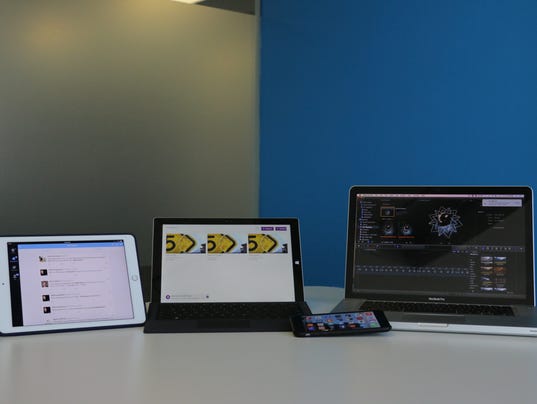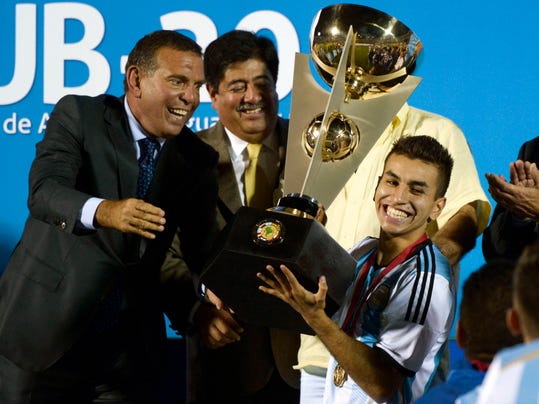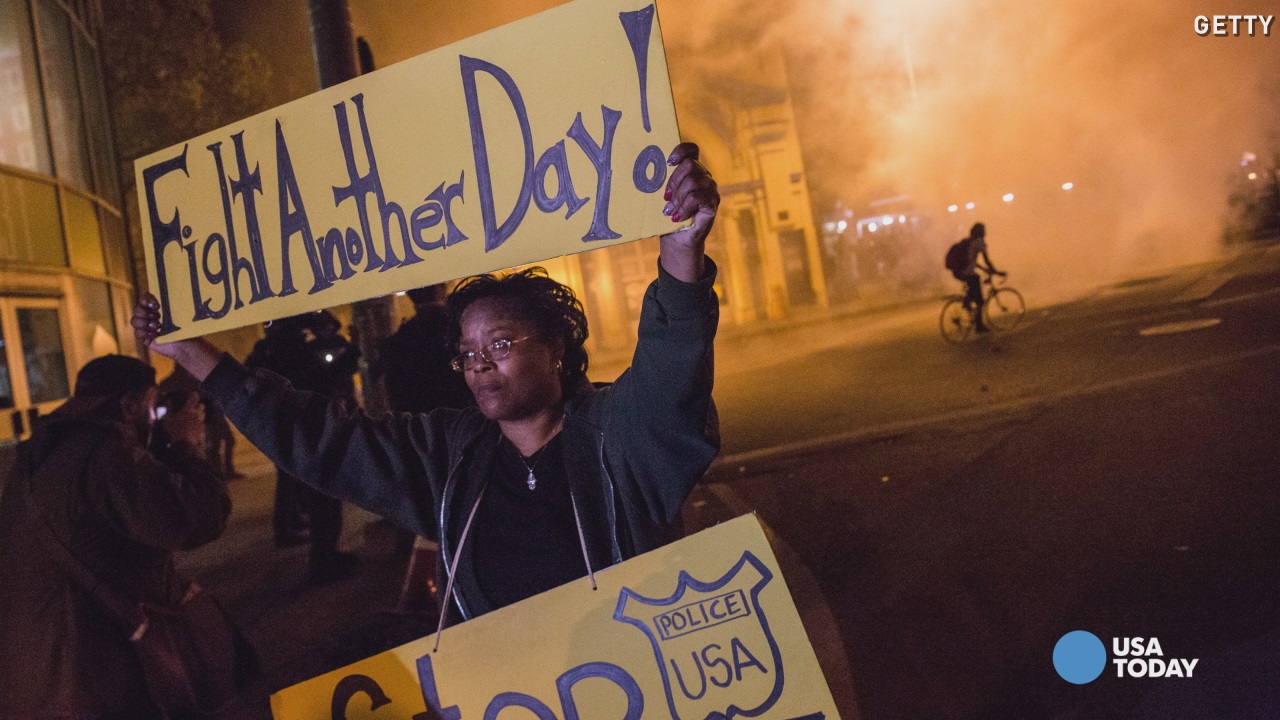ISLAMABAD, Pakistan — A former spokesman for the Pakistani Taliban, who last year defected from the group to help launch the Islamic State branch in Afghanistan, was killed in a recent U.S. drone strike in eastern Afghanistan, the Afghan intelligence agency said Thursday.
The strike in Nangarhar Province — which the U.S. military said took place Tuesday — killed more than two dozen Islamic State militants including Shahidullah Shahid, the one-time Pakistani Taliban commander, according to local media reports.
For years, Shahid was the chief spokesman for the Pakistani Taliban, frequently appearing in media reports to take credit for some of Pakistan’s grisliest terrorist attacks. Shahid’s public role made him a top target for Pakistani authorities.
But in October, Shahid surprised many analysts when he appeared in a video expressing support for the Islamic State and its supreme commander, Abu Bakr al-Baghdadi. The Pakistani Taliban, which viewed Islamic State as a rival and considers Mullah Omar to be its supreme leader, quickly severed ties with Shahid.
Shahid, however, emerged as a key leader of the Islamic State’s Khorasan chapter that is seeking to gain influence in Afghanistan and Pakistan.
Though the Islamic State so far has only a limited presence in Pakistan, the group has been making inroads in Afghanistan. Shahid was also believed to be the Islamic State’s chief spokesman in Afghanistan.
The U.S.-led coalition in Afghanistan had no immediate comment on the strike. But Afghanistan National Directorate of Security said it supplied the intelligence for the strike, which took place in Nangahar’s Achin district.
There was no immediate confirmation from Islamic State on Shahid’s reported death.
But Afghan intelligence officials said Gull Zaman, another top Islamic State commander, was also killed this week in a U.S. drone strike.
According to Long War Journal, a Web site monitoring conflicts including Afghanistan, Zaman was the deputy leader of the Islamic State’s Khorasan chapter. Afghan intelligence officials identified Zaman as the Islamic State’s “military operations deputy.”
Previously, Zaman had headed up the Pakistan Taliban’s operations in Pakistan’s Orakzai tribal area, according to the South Asia Terrorism Portal, which monitors violence in the region.
Read more: U.S. drone strike kills key Islamic State figure in Afghanistan
Z-Trace Blog - Blogging in 3rd Dimension
Thursday, July 9, 2015
Thursday, June 4, 2015
How to edit and share video as a citizen journalist

LOS ANGELES — Raw clips may work for tornado videos, but a citizen journalist with bigger ambitions needs to know how to edit.
In part 1 of this series, we showed you how to shoot broadcast-quality video on your smartphone with tools like microphones, tripods and selfie sticks. With the availability of smartphones and tablets with improved built-in cameras, anyone can now be a mobile journalist.
So now what? You want to take your raw clips, trim them, add titles and edit them in a quick masterpiece. And now we've all got portable computers in our pockets to do this, thanks to the smartphone.
Mobile editing will get the job done with the most basic of edits. I prefer to have the big screen and way more controls of the laptop, so I do most of my work there.
But that's me. Judd Slivka, who teaches mobile journalism classes at the University of Missouri, has his students do all their shooting and editing on mobile tools to speed up the process. "It cuts 25% of the time it takes to shoot and edit and get it done," he says.
HOW TO GET THE CLIPS OFF
Before we jump into mobile editing, let's take a quick minute to figure out where to find our footage, and how to get it off the devices.
On Apple devices, video clips are found in the "Camera Roll," or "Photo" app, while recent Androids house them in the "Photos" app.
Now say you want to shoot on the iPhone, but edit on the iPad. Or, you want to send your clips to a pal, who's an editor. Or, you bought a 16 GB iPhone, thinking it would have enough storage, only to realize that 8 GBs of it is taken up with the iOS operating system, and that there's just no room for your video files. You want to be able to move the files around.
Many think they can email the clips, and that will save the day. Not true. To fit the clips in the email, the resolution will be lowered and it won't be usable for your presentation. One easy solution: a cloud service like Dropbox is a great workaround for anyone with an Apple phone, since there's a direct Dropbox link in the Photos app. There's also Apple's AirDrop for sending files wirelessly from Apple devices. Many Android phones have slots for memory cards so the footage can go direct onto the cards. That's something the iPhone doesn't have.
For iPhone and iPad users, Slivka recommends the $59.99 Air Stash drive to his students. This is a wireless device that allows for transferring of files from device to device.
• Smartphone. Since you're shooting on the phone, the obvious first choice is to edit there. The limitations are the size of the screen — 4 inches to 5.5 inches, and less computing power than a laptop or desktop. But it certainly can be done.
If you have an iPhone, you'll want to start with Apple's iMovie, (free), which offers the basics: trimming, adding titles and a voice-over tool. There are many other decent options available now for either an automatic edit — sit back and let the computer do the work — or a more hands-on, manual approach.
Pinnacle Studio ($7.95) has more controls and choices than iMovie. A new app, Clips Video Editor, (free, Apple, with in-app purchases) is one of the more intuitive of the mobile video editors I've found, and promises to get more full-featured later this year. For Android, there aren't as many serious options. VivaVideo is one of the most popular, while Windows Phones has the new Movie Creator.
Read more: How to edit and share video as a citizen journalist
Thursday, May 28, 2015
Things to know about the Under-20 World Cup

WELLINGTON, New Zealand (AP) — The under-20 World Cup kicks off Saturday in New Zealand and will likely feature some of the stars of the future. Here's some things to know:
___
Welcome to the Land of the Long White Cloud: The 2015 FIFA Under-20 World Cup is the 20th edition of tournament which was first played in 1977. New Zealand is hosting the tournament for the first time, though this is the third occasion the event has been awarded to Oceania: Australia hosted the 1981 and 1993 editions. The 24 competing teams are divided into six pools which will play at seven venues around New Zealand. The host cities are Dunedin - the farthest south — and Christchurch on New Zealand's South Island and Wellington, New Plymouth, Hamilton, Auckland and Whangarei — the farthest north — on the North Island. The final will be held at Auckland's 25,000-seat North Harbour Stadium on June 20. A new champion will be crowned at that venue as France, the 2013 winner, failed to qualify.
___
FIFA and law enforcement agencies are confident they have measures in place to prevent World Cup matches and participating players being targeted by match-fixers. Director of security Ralf Mutschke said a comprehensive strategy had been put in place to ensure all matches are closely monitored by security personnel. Security will be tight around team hotels and players will be closely guarded at stadiums. Match fixing is a criminal offense in New Zealand and police and government agencies co-operate to identify illegal behavior. Julie Norris, head of Interpol's Integrity in Sport, Capacity Building and Training Program, said New Zealand was among the world leaders in the fight against sports corruption. "The level of cooperation and coordination and information sharing and intelligence sharing is certainly, in my experience, unprecedented," Norris said.
___
Argentina captain Angel Correa was recently named Player of the Tournament as Argentina won the South American qualifying championship for the Under-20 World Cup for the first time in 12 years. The achievement was made more impressive by the fact Correa had recently faced a health crisis that put his career in jeopardy. After winning the 2014 Copa Libertadores with San Lorenzo, Correa joined Atletico Madrid at the start of what seems likely to be an illustrious career. But a routine medical check detected a blocked ventricle in his heart and Correa had to travel to New York for an operation to remove the obstruction. The treatment was successful and, after being given medical clearance, he returned just in time to join Argentina's qualifying campaign. "It's great to be back playing again and to be feeling good too," Correa told Argentina's La Nación newspaper.
___
Few teams have traveled further to compete at the World Cup than Mali, but New Zealand is familiar ground to coach Fanyeri Diarra. Diarra was also coach of the Mali team which competed at the under-17 World Cup in New Zealand in 1999. "We didn't manage to make the second round on that occasion," Diarra said. "The draw wasn't kind to us, though. We found ourselves in a very tough group with Germany and the two eventual finalists: Brazil and Australia. Even so, we managed to hold our own, drawing two games and losing to Australia which cost us a place in the next round. We gave a good account of ourselves and we hope to do the same thing this year, while trying to go as far as we can."
Read more: Things to know about the Under-20 World Cup
Tuesday, May 19, 2015
China Just Gave Boeing a Big Boost

The airplane manufacturer landed a $6 billion order
Boeing can thank a booming travel industry in China for its latest windfall.
Chinese carrier Ruili Airlines and two leasing companies have placed an order with the Chicago-based plane manufacturer for 60 narrow-body jets, the official Chinese news agency Xinhua reports. The cost of the transaction will total more than $6.1 billion (or 38 billion yuan).
Ruili, the year-old Yunnan-based budget carrier, will purchase Boeing’s planes in order to expand its fleet to 56 jets, up from five, within the decade. The ordered model comes in three flavors: 737 MAX 7, 8, and 9, costing $87.7 million, $106.9 million, and $113.3 million, respectively, according to Boeing’s website.
Minsheng Financial Leasing and Avic International Leasing are the leasing companies that inked the agreement.
Wang Yukui, a Boeing spokesman based in Beijing, told Bloomberg that the company is pleased with the deal. “We are happy Ruili has selected the Boeing 737 MAX airplanes,” he said. “We look forward to finalizing details of the deal with them.”
Last year Boeing invested more than $800 million in China, Xinhua reports, and the company views the country’s fast-growing, decreasingly regulated market as a key opportunity for growth.
“Boeing’s strategy in China will serve China’s national strategy as well as the demand from Chinese customers,” Boeing China president Ian Thomas said late last year. “We not only sell aircraft in China, but we also support the future development of safety and efficiency in China’s aviation industry.”
Read more: China Just Gave Boeing a Big Boost
Wednesday, May 13, 2015
This Is the Selfie That Could Save Your Life

Every moment contains multitudes. In little more than the time it takes to blink, the heart muscles contract, pumping 5 tablespoons’ worth of oxygen-rich blood, while pulses of electricity ripple down the length of a neuron that then releases chemical signals to another — fleeting processes that together sustain the living machinery of our bodies. Engineer Keisuke Goda knows this, which is why he’s invented a camera that stretches out these events, frame by frame.
Goda’s camera is the world’s fastest, capable of filming tiny processes that happen in less than a millisecond, which could allow us to actually see how atoms behave in nuclear fission reactions or how shock waves might damage soldiers’ brain cells. Most recently, Goda has developed a device that would allow doctors to spot cancer cells rushing through the bloodstream before they spread to other organs — the cause of 90 percent of cancer deaths. Current imaging techniques aren’t sensitive enough to detect them.
At 40, Goda has published five papers in Nature, the most prestigious life sciences journal, as well as its sister journals. He’s part of a vast, burgeoning field, which emerged roughly two decades ago, that’s developing technology to image microscopic processes. But whereas most techniques involve repeating an experiment, photographing it at different time intervals and splicing the images together, Goda’s can capture multiple images in a single shot. Bahram Jalali, a UCLA physicist and Goda’s former supervisor, predicts his former student’s instruments will yield new scientific discoveries. Already, one of Goda’s instruments has led to the discovery of rare pulses of light known as optical rogue waves.
A camera that can take 4.4 trillion frames a second …
Goda looks ageless, his impish baby face darkened with thick stubble. He speaks breezily from his office in frenetic Tokyo, where he lives alone and directs two research labs that are nine time zones apart — one at the University of Tokyo, the other at UCLA. During his fleeting moments away from work, he watches Christopher Nolan’s time-bending epics, like Inception and Interstellar.
Growing up in Sapporo, he loved skiing and soccer and showed a flair for mathematical reasoning, winning countless Lego building competitions. He earned a Ph.D. in physics at MIT and conducted postdoctoral research at UCLA, developing astronomical instruments to detect faint signals from stars and galaxies. But he later switched to electrical engineering to apply his expertise to more earthly problems.
Attending imaging conferences, Goda wondered how he could apply his astronomy background to improving cameras. He knew that science often requires observing microscopic processes. The problem is: Things appear to move faster up close. Think of the last time you rode a train; cars in the distance probably seemed to be crawling, while houses along the tracks whizzed past. “The same thing happens in science,” Goda says. Digital cameras can take thousands of frames per second — but that’s still not fast enough to capture the details of microscopic processes.
Goda’s device could be used to screen stem cells before injecting them into patients.
Like all electronics, digital cameras are powered by the movements of electrons. Goda wondered whether using far smaller — in fact, massless — light particles called photons could speed up the process. So he developed a photon-based imaging technique known as serial time-encoded amplified microscopy, aka STEAM, which created images at 6.1 million frames per second, using laser pulses. A few years later, Goda kicked STEAM up a notch with sequentially timed, all-optical mapping photography, or STAMP, which can take 4.4 trillion frames a second, described in Nature Photonics last year.
Goda has also developed a device based on STEAM that can detect cancer cells migrating from a tumor through the bloodstream, before they seed in distant organs and cause the cancer to spread. In 1 milliliter of blood, 10 tumor cells hide among billions of blood cells. Today’s digital camera-equipped microscopes can’t detect them efficiently. But Goda’s device uses a microscope to photograph each cell in a patient’s blood sample as it flows through a narrow channel, analyzing its shape to identify it as cancerous or normal — in real-time.
The device could also be used in regenerative medicine. Although scientists have methods for converting regular cells into stem cells, which can then mature into multiple cell types, they don’t always develop into the correct type. Injecting the wrong type of cell into an organ — a lung cell into the stomach, for example — could cause it to become cancerous. Goda’s device could be used to screen these stem cells before injecting them into patients.
Read more: This Is the Selfie That Could Save Your Life
Wednesday, May 6, 2015
Deflategate probe suggests Patriots' Tom Brady aware of tampering, but clears Bill Belichick

An investigation into the so-called Deflategate scandal concluded it is more likely than not that New England Patriots quarterback Tom Brady "was at least generally aware of the inappropriate activities" by two team employees that resulted in balls being deflated below the allowable level for January's AFC Championship Game victory against the Indianapolis Colts.
The report, released Wednesday by attorney Ted Wells, found "it is more probable than not that Jim McNally and John Jastremski participated in a deliberate plan to circumvent the rules by releasing air from Patriots game balls," but found no wrongdoing by Patriots ownership, coach Bill Belichick and his assistants, or equipment manager Dave Schoenfeld.
Patriots owner Robert Kraft issued an immediate response, saying the organization is disappointed by the report, which lacked "any incontrovertible or hard evidence of deliberate deflation of footballs" after a three-month investigation triggered when Colts general manager Ryan Grigson tipped off NFL officials to the issue in an e-mail.
In a statement released in conjunction with the report, Commissioner Roger Goodell said NFL executive vice president Troy Vincent and his staff would consider possible discipline and changes to protocols to avoid similar issues in the future. The Colts said they're aware of the investigation's findings and have no comment.
The 243-page report features text messages between McNally, the 48-year-old officials locker room attendant for the Patriots, and Jastremski, a 35-year-old equipment assistant, in which McNally outs himself "the deflator" and the two friends discuss Brady's angry complaints about the inflation level of game balls in an Oct. 17 game against the New York Jets.
Brady, 37, signed autographs for the pair after the Patriots' divisional playoff win against the Baltimore Ravens, the report said, and communicated with McNally by phone or text message "with significantly increased frequency" in the days after suspicions arose publicly — conversations that were then shared in texts between McNally and Jastremski.
The report notes "there is less direct evidence linking Brady to tampering activities than either McNally or Jastremski." But after interviews with those two, investigators "do not believe that they would personally and unilaterally engage in such conduct in the absence of Brady's awareness and consent."
In a media session Jan. 22, the day before the Patriots left for Super Bowl XLIX in Arizona, Brady said he had "no idea what happened" and "would never do anything to break the rules. I believe in fair play, and I respect the league."
It was not immediately clear whether McNally or Jastremski remained employed by the Patriots, who beat the Colts 45-7 in the AFC title game — outscoring them 28-0 in the second half after officials restored the balls to proper inflation levels — and edged the Seattle Seahawks 28-24 in Super Bowl XLIX two weeks later.
Read more: Deflategate probe suggests Patriots' Tom Brady aware of tampering, but clears Bill Belichick
Wednesday, April 29, 2015
Schools reopen, Baltimore calm ahead of noon vigil

Schools reopened and streets were calm in Baltimore on Wednesday after an encouraging night that saw little of the angry chaos that has devastated Charm City in recent days.
A prayer vigil was planned for noon to honor Freddie Gray, the young black man whose death while in police custody set off more than a week of protests that had grown increasing confrontational.
One night after violent protests that saw buildings burned, stores looted and more than 20 police officers injured, Baltimore enjoyed a night of relative calm Tuesday as police and National Guard troops dispersed protesters and a curfew took effect without major disturbances.
Ten people were arrested Tuesday night, seven of them for violating the curfew, two for looting and one for disorderly conduct, Police Commissioner Anthony Batts said in a news conference. The numbers are a big improvement over the 200-plus arrests made Monday night.
Schools CEO Gregory Thornton welcomed students back to school with an open letter thanking "the thousands and thousands of students who made good decisions (Monday) and avoided the violence and law-breaking."
The letter also warned that students who did participate in Monday's violence will be held accountable.
"Principals and teachers are planning activities that will help students learn from the past days' events," Thornton said. "Counselors, social workers, and psychologists will be on hand to support students' emotional needs."
Meanwhile, investigations into the Gray case are going forward. Baltimore's police commissioner plans to present a report on the case to prosecutors by Friday, but it was unclear if or when the police will release any of the information.
The Justice Department has also opened a civil rights investigation into Gray's death, but has not indicated when any report would be issued. Department officials have met with Gray's family. The department issued a statement saying officials also had "participated in several meetings (Tuesday) with city leadership, law enforcement, faith leaders, young people and members of the community."
An autopsy is being conducted by the state medical examiner. Governor Larry Hogan told The Baltimore Sun that a preliminary report would be released "as soon as possible," but that a complete report would take several weeks.
In another probe, Baltimore State's Attorney Marilyn Mosby is looking into whether criminal charges are warranted against the officers involved in the Gray case. Six officers have been suspended with pay.
Gray died April 19, one week after being arrested and suffering a severe spinal injury. After Gray's funeral Monday, protests ostensibly against police violence quickly deteriorated into devastating riots. Bands of looters, some armed with crowbars, roamed the city, hurling rocks at police, destroying patrol cars, smashing store windows and torching buildings.
On Tuesday night, it looked as though more violent clashes between police and protesters were in store when members of the crowd hurled objects at police and officers responded by firing pepper pellets and smoke canisters into the crowd.
Read more: Schools reopen, Baltimore calm ahead of noon vigil
Subscribe to:
Posts (Atom)
